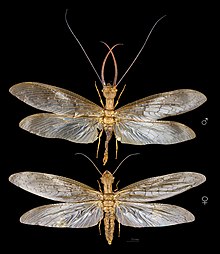| Corydalidae Temporal range:
| |
|---|---|

| |
| a Corydalus species | |
| Scientific classification | |
| Domain: | Eukaryota |
| Kingdom: | Animalia |
| Phylum: | Arthropoda |
| Class: | Insecta |
| Order: | Megaloptera |
| Family: | Corydalidae Leach 1815 |
| Subfamilies | |
The family Corydalidae contains the megalopterous insects known as dobsonflies and fishflies. Making up about three dozen genera,[1] they occur primarily throughout North America, both temperate and tropical, South America, Australia, New Zealand, Africa (particularly South Africa) and Asia.
They are sizeable Megaloptera, with a body usually larger than 25 mm (1 inch). They often have long filamentous antennae, though in male fishflies they are characteristically feathered. Ocelli are present; the fourth tarsal segment is cylinder-shaped. The four large wings are translucent, smoky grey, or mixed, and the anterior pair is slightly longer than the posterior one. Their aquatic larvae are used as fish bait and are called hellgrammites. The larvae are aquatic, active, armed with strong sharp mandibles, and breathe by means of abdominal branchial filaments. When full sized — which can take several years — they leave the water and spend a quiescent pupal stage on the land, in chambers dug under stones or logs, before metamorphosis into the sexually mature insect.
-
Parachauliodes japonicus
-
Larva
- ^ See references in Haaramo (2008)

